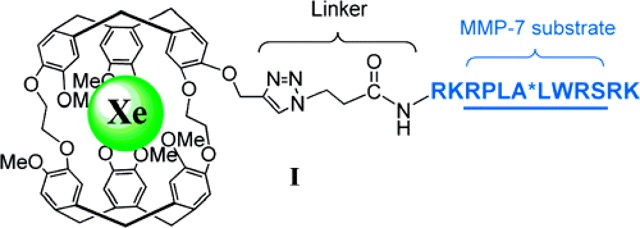A nuclear magnetic resonance (NMR) based enzyme-detection system comprising xenon (129Xe) biosensors complexed with an enzyme-specific peptide substrate.
Problem:
In 2023, about 298,000 American women will be diagnosed with breast cancer, with an estimated 43,700 deaths. Early cancer detection in the localized stage increases the five-year relative survival rate by up to 99%. Despite this, conventional methods are not highly effective in detecting cancer cells at an exceedingly early stage.
Solution:
129Xe biosensors offer an attractive alternative to conventional MRI methods due to their higher sensitivity and improved magnetic signal. Conjugating with respective substrates 129Xe MRI contrast reagents allow more accurate detection of the activity of different enzymes in biological samples, including and not limited to early biomarkers of breast cancers such as matrix metalloproteinases (MMPs). Early detection is among the most promising approaches to reducing the growing cancer burden.
Technology:
The biosensor utilizes a hyperpolarized element 129Xe, in complex with a cryptophane-A coupled peptide. The peptide is a substrate-specific to the target enzyme. As the enzyme interacts with the biosensor, it cleaves its substrate, causing electrostatic environment changes in the element.129Xe NMR spectroscopy can distinguish between the intact and cleaved biosensors with high sensitivity, enabling analysis of the chemical shift to indicate the activity of enzymes, including metalloproteinases for early breast cancer diagnosis.
Advantages:
- Enables high-resolution, high-sensitivity detection of different early biomarkers of breast cancer
- Wide chemical-shift window (> 200 ppm in water)
- Large signal (10-70% alignment of Xe nuclear spins compared to thermal polarization of 0.00027% at 37C and 3T)
- Simultaneous detection of different MMPs can help distinguish cancer cells from healthy cells more accurately
- Allows multiplexing using different cryptophanes to help identify aggressive tumor phenotypes

Structure of an MMP-7- responsive 129Xe biosensor. Underlined in blue is the preferred peptide substrate of MMP-7, and the star indicates the enzyme cleavage site.
Case ID:
R3978-tpNCS-02
Web Published:
7/18/2023
Patent Information:
| App Type |
Country |
Serial No. |
Patent No. |
File Date |
Issued Date |
Expire Date |